Oxidative CH alkynylation of 3,6-dihydro-2H-pyrans
2019-07-27RnZhoGuiongFengXioongXinHonghoGunJingHuRenzhongWnWeiLiLeiLiu
Rn Zho,Guiong Feng,Xioong Xin,Hongho Gun,Jing Hu,Renzhong Wn,*,Wei Li,*,Lei Liu,*
a Department of Pharmaceutical Analysis, School of Pharmacy, Shandong University of Traditional Chinese Medicine, Ji[2]'nan 250355, China
b College of Animal Science and Veterinary Medicine, Shandong Agricultural University, Taian [23]271018, China
c School of Chemistry and Chemical Engineering, Shandong University, Ji[2]'nan 250100, China
d State Key Laboratory for Chemistry and Molecular Engineering of Medicinal Resources, School of Chemistry and Pharmaceutical Sciences of Guangxi Normal University, Guilin 541004, China
Keywords:3,6-[27]Dihydro-2H-pyrans CH [28]Functionalization Alkynylation Oxidation Organoborane
A B S T R A C T Current synthesis of α-substituted 3,6-dihydro-2H-pyrans dominantly relies on functional group transformation. Herein, a direct and practical oxidative CH alkynylation and alkenylation of 3,6-dihydro-2H-pyran skeletons with a range of potassium trifluoroborates is developed. The metal-free process is well tolerated with a wide variety of 3,6-dihydro-2H-pyrans,rapidly providing a library of 2,4-disubstituted 3,6-dihydro-2H-pyrans with diverse patterns of α-functionalities for further diversification and bioactive small molecule identification.
[29]α-Substituted 3,6-dihydro-2H-pyrans (DHPs) are common structural motifs in a number of biologically active natural products and synthetic pharmaceuticals [1]. Their current synthesis predominantly relies on four types of oxygen-heterocycle construction approaches: (1) Prins-type cyclization of homopropargylic alcohols and aldehydes[2];(2)[4+2]cycloaddition of dienes and aldehydes [3]; (3) ring-closing metathesis [4]; (4)intramolecular alkene alkoxylation [5]. Despite wide synthetic applications, these methods rely heavily on the functional group transformations. On the other hand, a great number of methods have been established for the facile access to the DHP skeletons with diverse substituent patterns. Accordingly, direct manipulation of the DHP skeletons with a multitude of readily available coupling components through the structural-core diversification strategy represents an attractive alternative to traditional oxygenheterocycle construction strategy.[30] Pallidium-catalyzed Heck reaction of 3,4-dihydro-2H-pyrans represents a practical protocol for[25]αsubstituted DHP synthesis. However, the method is only suitable for the access to [25]α-aryl substituted DHPs [31][6]. In this context, the Ferrier reaction involving the substitution of CO bonds with CC bonds at C1position of DHP-based acetals is the most widely adopted approach [6,7]. However, the method suffers from extra steps for pre-installation of the acetal functionality.
Direct CH functionalization of DHPs represents an ideal approachtoaccessthetargetwithaminimalamountofintermediary refunctionalizations and with high atom economy[8–10]. Magnus has reported an isolated example of one-pot allylation of DHP-based triisopropylsilyl enol ethers with allyl tri-n-butylstannane and Me2AlCl (Scheme 1a) [11]. Wu disclosed one elegant example of photoredoxinducedCHalkylationofDHP withelectron-deficient benzylidenemalononitrile (Scheme 1b) [12]. Our group documented a Ph3CClO4mediated CH functionalization of DHP with potassium(phenylethynyl)boronate(Scheme 1c)[13].Albeit great innovation,these studies still suffer from the employment of toxic organotin, limited DHP scope and α-substituent pattern, or expensive oxidative reagent. On the other hand, alkynes are common structural elements pervading the realms of biology,chemistry, material science, and medicine and serve as valuable building blocks due to their versatile chemical reactivities [14].Given the importance of 2,4-disubstituted DHPs in pharmaceutical science[1eg],a systematic study on the CH alkynylation of 4-substituted DHPs using readily available oxidant would be a highly attractive project to pursue(Scheme 1d).
Initially,the CH alkynylation of 4-phenyl substituted DHP 1a with boronate 2a was selected for the optimization of suitable oxidant(Table 1).Common oxidants,includingtBuOOH,PhI(OAc)2,and TEMPO+BF4(TEMPO=2,2,6,6-[32]tetramethylpiperidin-1-oxyl)failed to effect the coupling(entries[3]1–3).Ph3CClO4promoted the reaction,and expected 3a was isolated in 32%yield(entry[34]4).When DDQ (2,3-dichloro-5,6-dicyano-1,4-benzoquinone) was used, the reaction proceeded smoothly, affording 3a in 90% yield.
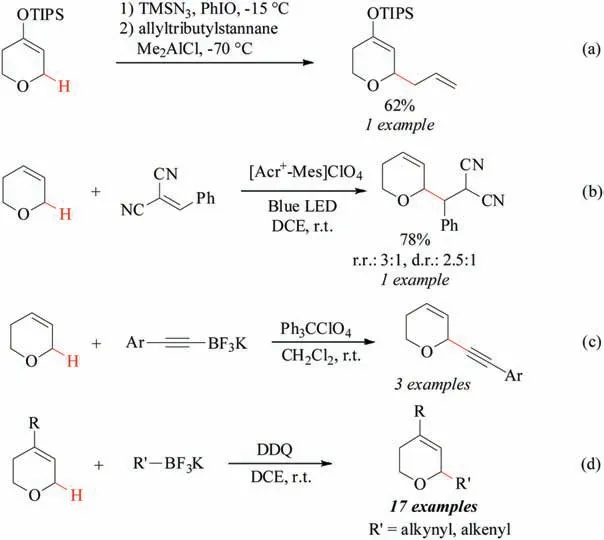
Scheme 1. Overview of CH functionalization of DHPs.

Table 1Reaction condition optimization.a
The substituent effect on DHPs 1 was explored(Scheme 2).DHPs bearing either electron-donating (1b-1d) or -withdrawing aryl moieties(1e)at the C4-position were found to be well compatible with the oxidation condition, providing corresponding 3b-3e in high efficiency.DHP 1f with a meta-methyl substitutedarylgroup at the C4-position proved to be a suitable substrate for the CH alkynylation process, and 3f was obtained in 91% yield. DHP 1[35]g having a heteroaryl moiety at the C4-position was well tolerated,and 2-thiophenyl substituted 3[36]g was isolated in 82% yield. DHPs bearing a spirocycle at α positionwere also competent components,asdemonstratedbytheformationofmultiple-substituted3[37]h in80%yield.Noreactionwas observed for DHP 1i,which might be ascribed to the increased oxidation potential of the substrate.
The scope of alkynyl boronates 2 was next investigated(Scheme 3). Electronically varied potassium (arylethynyl) boronates 2b-2f participated in the oxidative coupling with DHP 1a smoothly, affording corresponding 4b-4f in good yields. Heteroarylacetylenes were competent components for the process, as demonstrated by the efficient generation of 4[38]g in 83% yield.Alkylacetylene 2[39]h also proved to be a suitable component, and expected 4[40]h was obtained in 80% yield. Alkylacetylene 2i bearing benzyl ether was well tolerated for further manipulation.A gramscale CH alkynylation of 1a proceeded in 83% yield, thus indicating the practicability of the method.
Besides the alkynylation process,CH alkenylation of DHP 1a with 5 was well tolerated under the standard oxidation condition,furnishing the expected 6 in 85% yield (Scheme 4). No expected CH arylation or allylation product was observed when respective aryl or allyl potassium trifluoroborate was used as the coupling component.
The synthetic utilities of the protocol were next examined(Scheme 5). The alkene moiety in DHPs can act as a reactive handle fordiverse functionalization,as exemplified by the efficient hydrogenationof4cand diastereoselective epoxidation of 3a,giving respective tetrahydropyrans 7 and 8 with diverse substituent patterns.
According to the mechanistic studies on DDQ-mediated benzylic ether oxidation[15],a mechanism for C–H alkynylation of DHPs was suggested(Scheme 6).DHPs 1a proceeded through a single electron transfer(SET)to DDQ provided radical cation 9 together with DDQ radical anion 10.The radical cation 9 might either undergo a proton abstraction by 10 followed by another SET or a hydrogen atom transfer(HAT)to 10,furnishing α,β-unsaturated oxocarbenium ion 11. Subsequent nucleophilic attack of potassium trifluoroborates onto 11 afforded the expected product 12.
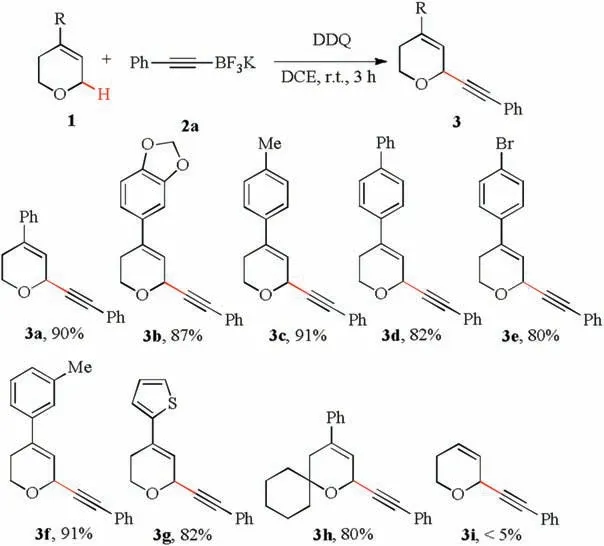
Scheme 2. Scope of DHP components. Reaction conditions: 1a (0.1 mmol), 2a(0.12 mmol),and DDQ(0.11 mmol)in DCE(1.0 mL)at r.t.for 3 h.The yield refers to isolated yield.
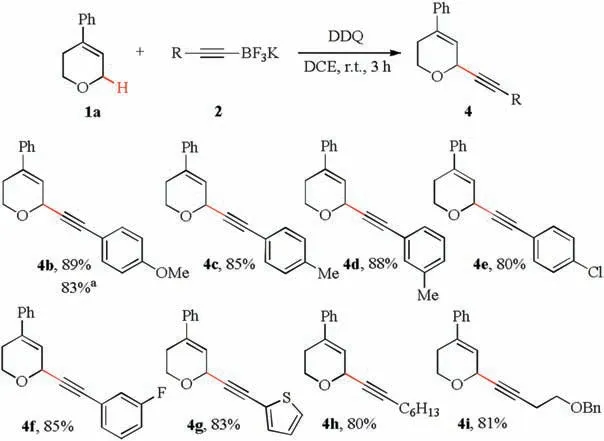
Scheme 3. Scope of alkynyl boronates. aReaction in a 1.0 g scale.

Scheme 4. Oxidative CH alkenylation of DHP 1a.
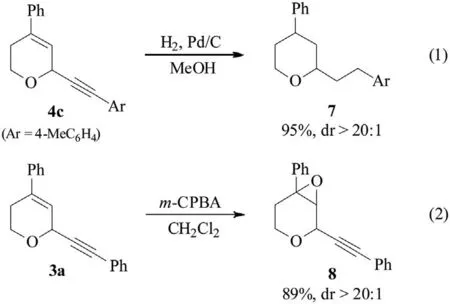
Scheme 5. Synthetic utilities.
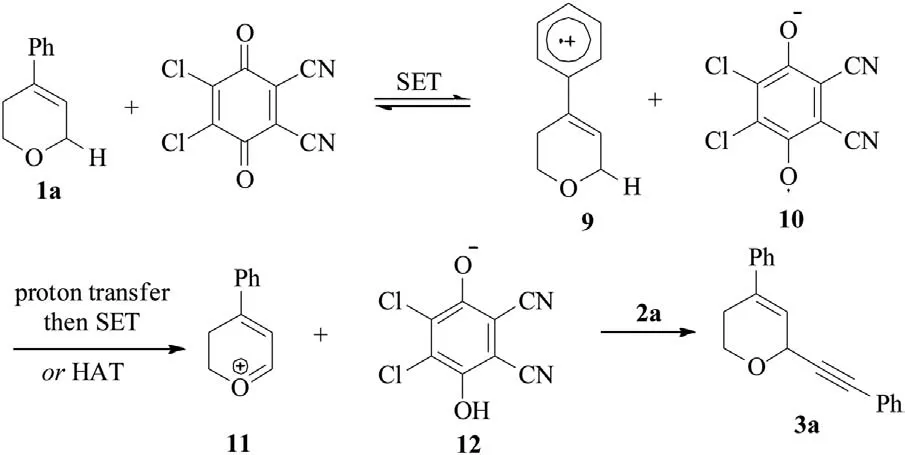
Scheme 6. A proposed mechanism.
Inconclusion,anefficientandpracticalmethodforthepreparation of [25]α-substituted DHPs is described. Under DDQ-mediated mild metal-free conditions, diverse DHPs undergo oxidative C–H alkynylation and alkenylation with a range of potassium trifluoroborates smoothly,rapidly providing a library of 2,4-disubstituted DHPs with diverse patterns of [25]α-functionalities for further diversification and bioactive small molecule identification.
Acknowledgments
This work was financial supported by the [41]National Natural Science Foundation of China ([42]No. 21722204), Fok Ying Tung Education Foundation ([43]No. 151035), the Key Laboratory for Chemistry and Molecular Engineering of Medicinal Resources(Guangxi Normal University)([4]No.CHEMR2016-B09),and Guangxi Funds for Distinguished expert.
Appendix A. Supplementary data
Supplementarymaterialrelatedtothisarticlecanbefound,inthe online version,at doi:https://doi.org/10.1016/j.cclet.2019.03.027.
杂志排行
Chinese Chemical Letters的其它文章
- Sonochemical synthesis of silver nanoparticles coated copper wire for low-temperature solid state bonding on silicon substrate
- Significant enhancement in water resistance of Pd/Al2O3 catalyst for benzene oxidation by Na addition
- From interpenetrating polymer networks to hierarchical porous carbons for advanced supercapacitor electrodes
- Two alkynyl functionalized Co(II)-MOFs as fluorescent sensors exhibiting selectivity and sensitivity for Fe3+ and nitroaromatic compounds
- A novel mitochondria-targeting tetrapeptide for subcellular delivery of nanoparticles
- Hyperbranched polylysine:Synthesis,mechanism and preparation for NIR-absorbing gold nanoparticles
